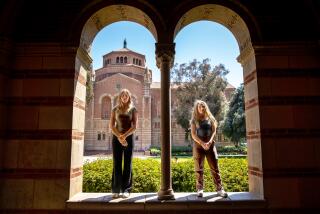Attorney May Seek to Test Ramon Salcido at UC Irvine Brain Center
- Share via
An attorney defending accused mass murderer Ramon Salcido may seek permission to have him tested in Orange County to determine whether the 28-year-old winery worker suffers from physiological brain damage.
“I’m trying to see if there is any (organic) or physiological damage to his brain,” said Sonoma County Chief Public Defender Marteen Miller.
Salcido is accused of killing his wife, two of his daughters, his mother-in-law, her two daughters and a winery co-worker in April. He is also accused of trying to kill another daughter, Carmina, who survived, although her throat was slashed. Salcido’s mental state may have a bearing on the way Miller defends him in court.
Miller said he contacted Dr. Francis Crinella, who directs a research institute at Fairview Developmental Center hospital in Costa Mesa, and expressed an interest in having Salcido examined with a state-of-the-art brain-imaging technique at UC Irvine.
The tests may be conducted in Orange County, Miller said, because some medical professionals contacted in Northern California have been unwilling to work with the accused murderer.
Miller said he was told by Crinella that the new technique, positron emission tomography, which allows researchers to map brain function, is “pretty definitive” in determining physiological brain damage when combined with other tests.
“There are certain neurological signs that we’d like to elaborate,” Miller said. “We have reason to believe that we’re going to find some physiological damage.”
Miller said he will continue to search for Northern California medical professors who would be willing to examine Salcido. However, if he fails, he is expected to ask a Sonoma County judge on Friday for permission to have Salcido brought from Northern California to the Brain Imaging Center at UC Irvine.
Crinella, who is a clinical professor at the university’s College of Medicine, also said he was reluctant to test Salcido and preferred that the criminal defendant be examined in Northern California.
“We’re hopeful that it could be arranged up in that area,” Crinella said. “We’re certainly not trying to solicit this business, but in the event that Mr. Miller cannot find adequate neurological diagnostic services in Northern California, it probably could be arranged down here.”
The imaging technique is so new that Monte Buchsbaum, who directs the university’s Brain Imaging Center, became the first researcher to make the so-called PET brain images available for use as legal evidence, according to the university’s public information office.
While other imaging techniques reveal only brain structure, the PET scanner records the amount of a radioactive sugar absorbed by brain cells and identifies those areas of the brain that are working hardest.
Statistical comparisons are then made with people with normal and abnormal brain function and from these, researchers have determined that PET images act as distinctive fingerprints for various mental disorders.
More to Read
Sign up for Essential California
The most important California stories and recommendations in your inbox every morning.
You may occasionally receive promotional content from the Los Angeles Times.












